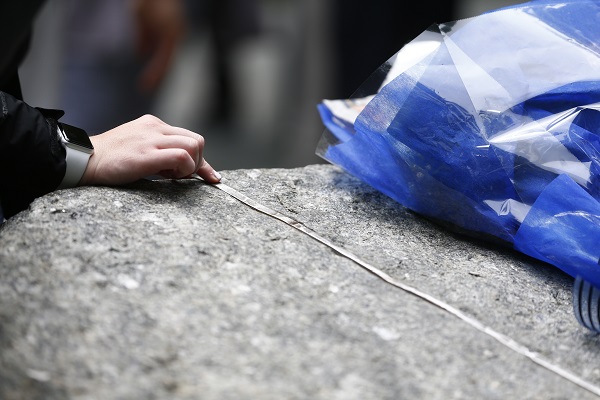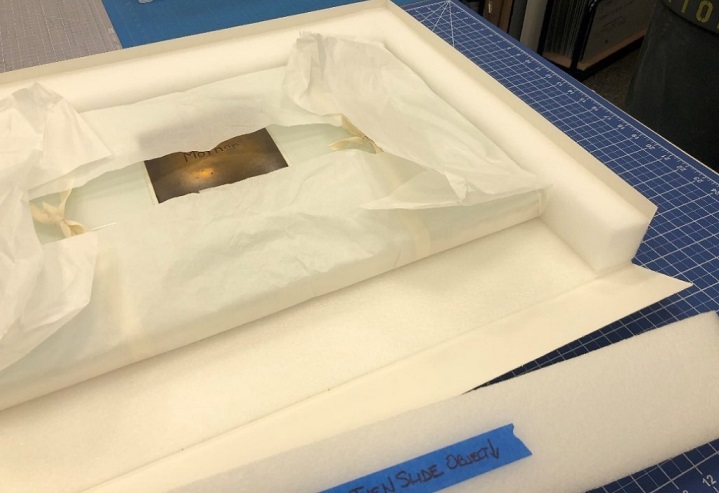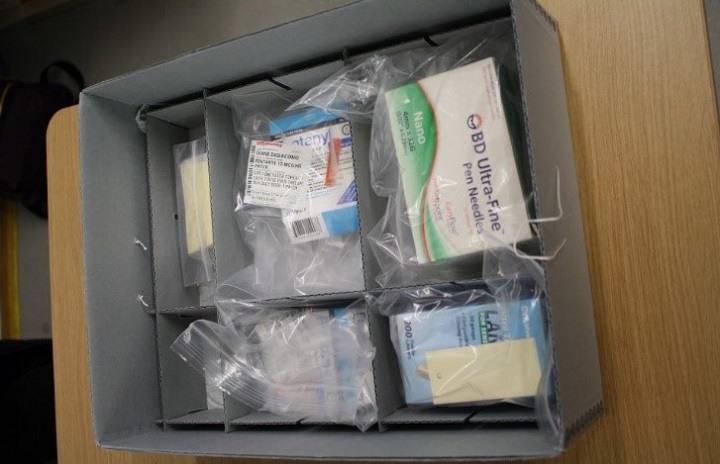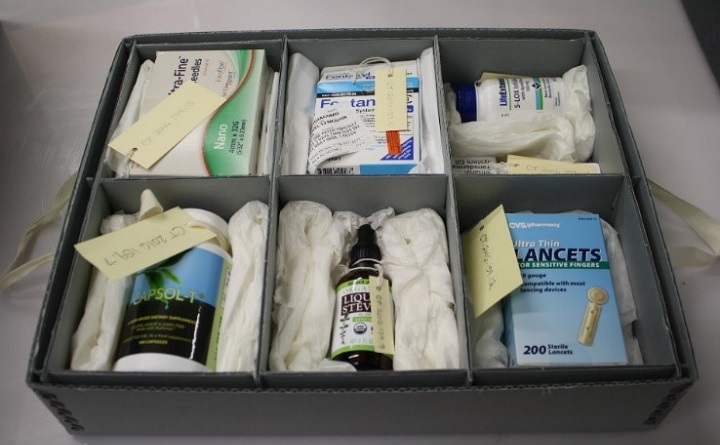Make a donation to the museum
Behind the Collection: Rehousing Diverse Artifacts at the 9/11 Memorial & Museum
Behind the Collection: Rehousing Diverse Artifacts at the 9/11 Memorial & Museum
A plastic hard hat worn by a recovery worker, a mangled steel beam recovered from Ground Zero, a postcard of the Twin Towers, the blue and yellow china from Windows on the World. These are just a small sampling of the artifacts that fill our diverse collection. Caring for this expansive array of objects, one of the many facets of the Museum’s behind-the-scenes operations, help to illuminate the stories of victims, rescue and recovery workers, survivors, and witnesses. Accordingly, collections management staff are tasked with assessing how to best store each object as well as designing and producing custom housing solutions for the safe, long-term storage of this vast collection.
Proper housing stabilizes an object for storage using interior and exterior supports. These are crafted from chemically inert materials such as acid-free corrugated blue board, tissue paper, and polyethylene foam, which help minimize the deterioration of objects. Rehousing an object can be as simple as placing a letter inside an acid-free folder, while delicate or fragile objects may require a skilled hand to customize foam cavities which fit objects snugly, yet without introducing excess pressure. Caring for a plastic hard hat is obviously quite different from caring for a mangled steel beam, but the purpose remains the same: to ensure the longevity of the collection. Below are several projects highlighting how we create custom housing to support the preservation of our diverse collections.
alt

Glass is a seemingly simple, albeit fragile, material to house. However, there are always special considerations when planning for its storage. These wheat beer glasses from the Marriott World Trade Center’s Tall Ships Bar & Grill aren’t particularly heavy, but their distinctive curve, wide rim, and narrow base required stabilization. Foam is an optimal material for stabilization as it is light and easily cut into any shape. For the glasses, we outfitted a tray with compartments and padded the bottoms with soft foam to cushion the objects; foam planks were then carved to fit the size and shape of the glasses (leaving some space for fingers to grasp the objects when removing them). Cut foam creates an abrasive surface that has potential to mar the glass, so we used tissue as a buffer before nesting the objects in their cavities.
Gift of Sandra Bloodworth with the consent of the Metropolitan Transportation Authority. Photos by 9/11 Memorial & Museum Staff.
An unrealized proposal for the redesign of the Cortlandt Street subway station, which was damaged on 9/11, this maquette weighs approximately 30 pounds and is comprised of glass tiles and a cast bronze inset. The maquette’s weight posed the greatest challenge for its rehousing. For an object of this heft, choosing a sturdy container and minimizing the potential for movement are paramount. For this, we selected a large box with a drop-front and lined the bottom with soft foam. We then adhered foam planks to pad three of the four sides. Since lifting the object can be difficult or potentially dangerous, it should slide to and from the container. To enable that mobility, we left one of the four foam planks unglued and thus removable. We fabricated two “handles” of cotton twill, tied them loosely around the object, and wrapped it in tissue to act as a buffer and improve ease of movement. Guided by the directions written on the loose foam plank, future collection handlers will know to remove it and slide the object from its protective container.

Collection 9/11 Memorial Museum, Memorial Tribute Archive. Photo by 9/11 Memorial & Museum Staff.
In anticipation of the 9/11 Memorial Glade Dedication Ceremony on May 30, 2019, “Stars of Hope” were cut from plywood, painted by volunteers, and tied to a construction fence temporarily enclosing the site. From these multiple, colorful tributes, we selected five for retention in the Museum’s Memorial Tribute Archive. During their display outdoors, weather exposure caused slight chipping, cracking, and warping. Sensitive surfaces and planar distortions such as these present their own rehousing challenges. To prevent further damage, we created stackable cradles with foam spacers to limit movement and protect their painted surfaces. Each star received its own tray and was lowered into a banker box for protective, long-term storage.
Gift of the DiGiacomo Family. Photos by 9/11 Memorial & Museum Staff.
During a comprehensive inventory of the Museum’s physical collection that took roughly three years to complete, the inventory team addressed collection rehousing in addition to the primary goal of providing an accurate accounting of the Museum’s holdings. This exercise became especially critical after a call for donations resulted in thousands of submissions over a relatively short period of time. Easy-to-implement methods were used during the inventory to address rehousing needs on a high level. For example, many donations had yet to be removed from the packaging they arrived in. Museum Collections staff not only confirmed objects’ locations and documentation, but also rehoused these acquisitions to current archival standards. These before-and-after photos show objects relating to the medications taken by a 9/11 responder who became ill as a result of her service. Nothing particularly time-consuming was required; staff first confirmed that packaging and bottles were empty of medication and sharp objects. They then improved the housing by removing objects from plastic bags that stifle air exchange, labeled each with its accession number for easy identification, and placed objects into a compartmentalized tray lined with tissue.
alt
Although objects in the Museum’s collection are given permanent storage locations, occasionally objects must be transported for purposes of exhibition or loan to other institutions. A member of the Collections team usually escorts the object(s) to the destination. In these instances, objects that might not be stored together long-term are often placed in one temporary container to minimize travel impact. Here, a Collections specialist uses various types of foam to securely pack a placard and framed photograph for shipment.
The work of a collections care specialist is an often-unseen aspect of a museum’s essential daily operations. These objects, held in the public trust, require constant monitoring, maintenance, and expert handling to ensure their long-term safety.
As evidenced by the myriad solutions featured here, such positions require patience, strategic thinking, and creativity to design the housing this unique national heritage collection commands. The physical care invested in objects behind-the-scenes is for the larger purpose of aiding the Museum’s ability to tell a story in perpetuity, and protect primary evidence associated with those accounts.
In the case of the 9/11 Memorial & Museum, those stories extend beyond the events of February 26, 1993 and September 11, 2001. They also convey stories of hope, resourcefulness, and resilience in a time when it seemed there could be none. Those stories are told here through the objects cared for each day—objects highlighting human compassion that was expressed worldwide.
By Christina Chavez, Collections Management Assistant, and Danielle Butterly, Inventory Technician, 9/11 Memorial & Museum
Previous Post
Musician Recalls Coordinating the Volunteer Effort at Ground Zero

"The thing that really broke my heart the most was seeing the physical guys on the site who did not have the supplies they needed to do their job."
Next Post
“Dear Hero” Letters Honor Frontline Workers
We invite you to share your own message of gratitude and appreciation for those on the frontline by participating in our “Dear Hero” campaign.



